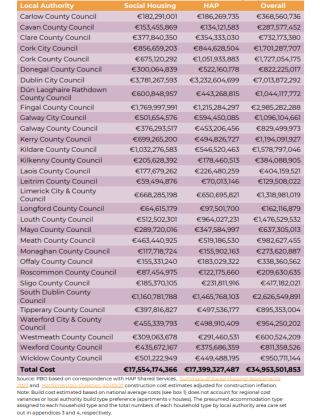Accurate Measurement is Essential for Addressing Social Housing Needs

The Parliamentary Budget Office (PBO) this week published 'Social Housing – Ongoing Need 2023' with the aim of providing an overview of the social housing demand at local authority level. The PBO define ‘Ongoing Need’ as the "gap which exists between the official measurement of the unmet need and the actual number of households who may require long term social housing. The term quantifies the number of households that are on the main social housing waiting list plus those households in receipt of the Housing Assistance Payment (HAP)." Based on this criteria, the PBO calculate that 4.4 per cent of the entire Irish population has an ongoing need for social housing. This equate to approximately 235,659 people, of which 92,116 (39 per cent) are children.
Assessing Need
The Department of Housing and the local authorities need to gauge 'unmet need' for social housing when they develop their plans for delivering social housing. They need to know how many units and where they should go. This 'unmet need' is worked out using the main local authority social housing waiting lists as this gives the number of households who qualify for social housing but have not yet accessed it. However, this figure does not take into account households whose rent in the private sector supported by the Housing Assistance Payment (HAP), as their social housing needs are deemed to be ‘met'. The PBO notes that "as HAP tenancies are private rental agreements without the additional security of tenure afforded local authority tenants, these households have an ongoing need for social housing and should also be tracked and considered when planning for social housing delivery."
Change in Ongoing Need by Household Make-Up
The PBO state that it is important to understand who is living in these households if we are to match supply with demand. Table 1 shows the changes in the ongoing need by household composition.
Between 2022 and 2023, the number of households with an ongoing need reduced by 1.27 per cent (1,461 households). The PBO found that "almost all waiting list and HAP household categories have seen either a reduction or only slight increases in absolute numbers." This reduction in HAP tenancies was the most significant, with the largest reductions see in either ‘single adult’ households or and ‘single adult with children’ households. These groups tend to be the most ‘at risk’ in housing terms due to the lack of appropriate accommodation and that the cost of the rent (usually) falling to a single individual. Without accurate data, it is unclear as to the reasons for households exiting HAP.
In general, local authorities have tended towards building bigger family homes and Approved Housing Bodies (AHBs) usually provide a much larger proportion of apartments (typically 1 bedroom) that are aimed at single individuals - the cohort with the largest ongoing need (see table 1). The lack of a detailed report on the reasons for households exiting HAP means that an accurate analysis of need is difficult to assess and may in turn impact on the planning and delivery of social housing.
Table 1: Changes in Unmet Need and HAP Tenancies from 2022 to 2023

Where is the need at local level?
The PBO note that whilst the national picture is important, "quantifying that need at a local level allows us to see where intervention is required most". Their key findsings were that:
- Kildare has highest share of households on the main social housing lists, at 66% of their total ongoing need;
- Louth has 64% of households with an ongoing need in receipt of HAP, the highest in the country;
- Of all the local authorities in Dublin, South Dublin County Council has the highest percentage share of active HAP tenancies, accounting for 55% of their total ongoing need;
- Fingal County Council has the lowest share of HAP tenancies at 40%, and the highest percentage of households in Dublin on the social housing waiting lists, at 60%.
Estimating the Cost of Building Homes for the Ongoing Need
The PBO estimate that it would cost the State €17.55 billion to build new, appropriate, permanent social housing for every household currently on the Social Housing waiting list and another €17.40 billion if every household in receipt of HAP was to be provided with the same. The total build cost for all households with an ongoing need is estimated to be €34.95 billion. They also provide a breakdown of this figure across all local authorities in Table 1.
Table 1: Estimated Costs of Building Accommodation for the Ongoing Need

Social Justice Ireland welcomes this report as we have long stated that the supply of social housing is far below requirement and that the real need for social housing is grossly under-reported as those in HAP and RAS tenancies, refugees, Direct Provision and many at risk of losing their home due to mortgage arrears are not included. To meet the need, Government should set a target of 20 per cent of all housing stock to be social housing and to achieve this through new builds. This increase in the State’s social housing stock would move households from the private rental market into this social housing. In practice, these vacated houses would then become available for renting to private tenants; which would increase supply, reduce demand, and encourage a fall in rental prices.
